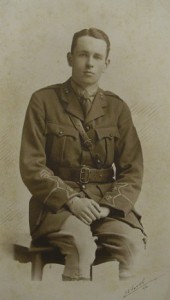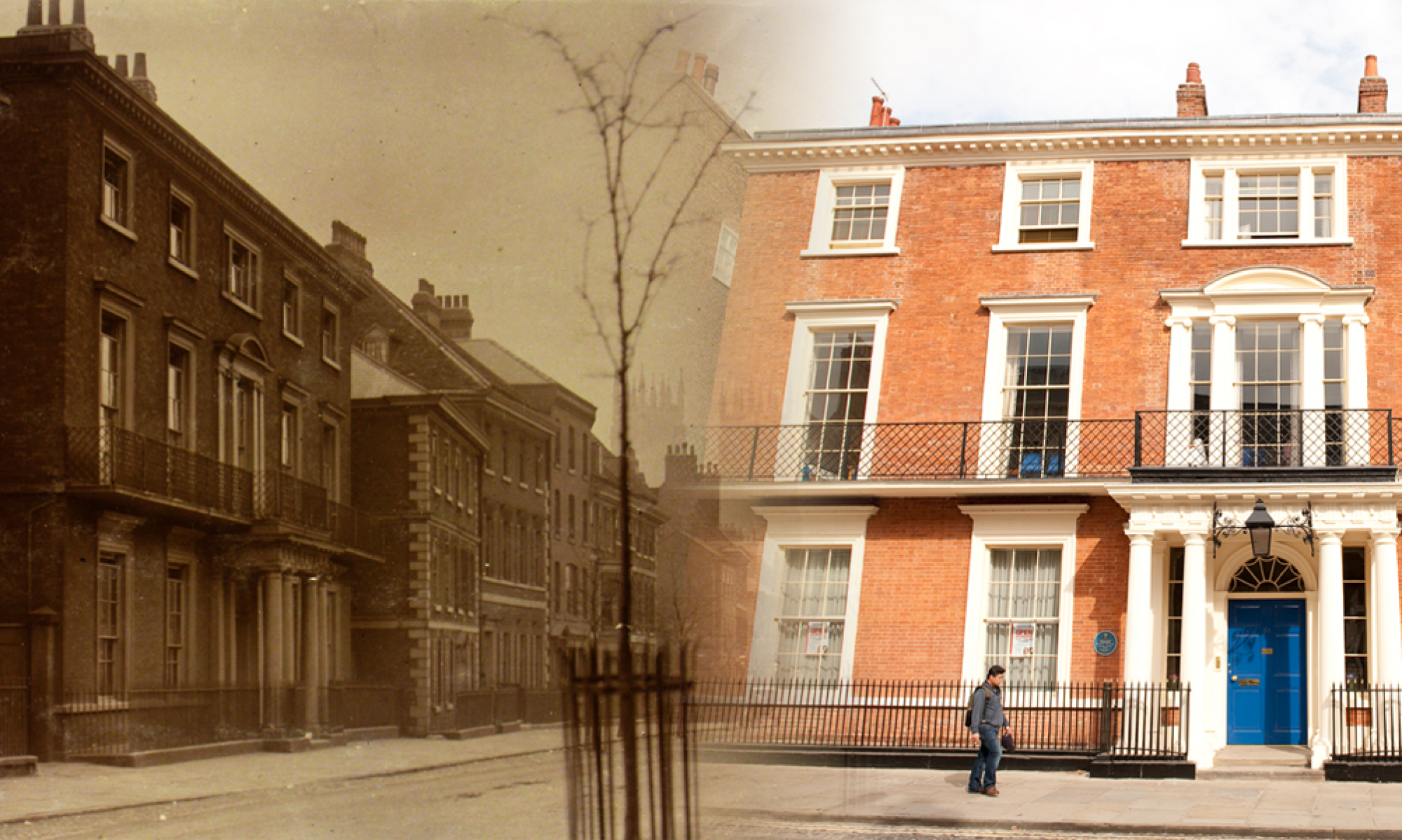
John Lancelot Gibson, of Newcastle-on-Tyne, was killed in action in France on the 27th May, 1918, aged 22 years.
Lance was born in 1896 and attended Bootham School from 1910 to 1913. He was a good cricketer and enjoyed Entomology at school. The school magazine, “Bootham”, contains details of his collecting.
The March 1911 issue of “Bootham” contains The Seventy-seventh Annual Report of Bootham School (York) Natural History, Literary & Polytechnic Society, January, 1911:
“NATURAL HISTORY DIARIES.
“Of the diaries by younger boys that by Fisher is undoubtedly the best. He gives a good account of the type of animal which lives in the shells he collects. Others deserving of encouragement are A. S. Hamilton, Wilson, Lambert, Smithson, Benson, Gibson, Carr and Schad.
PRIZE LIST.
NATURAL HISTORY.
Natural History Diaries J. L. Gibson,
WORKSHOP.
Vivaria, &c. J. L. Gibson”
“Bootham” of May 1911 contains the school Athletics Report:
“JUNIOR CUP.
100 Yards 2 J L Gibson.
220 Yards 2 J. L. Gibson
120 Yards Handicap (Junior) 2 J. L. Gibson”
The March 1912 issue of “Bootham” contains The Seventy-eighth Annual Report of Bootham School Natural History, Literary & Polytechnic Society. January, 1912:
“NATURAL HISTORY CLUB.
At the beginning of the Autumn Term a small exhibition of Holiday Work was held in the Art Room. The Plants of J. M. Goodbody and G. S. Adair, together with the Beetles of J. L. Gibson, deserve special mention,….
ENTOMOLOGY.
Gibson and Benson both made excellent collections of beetles. Gibson, who has only collected a year shows very careful work, but better arrangement of his localities would be desirable.
(Report of Christmas Show says that “The two beetle collections are good ones. Taking into account the year’s work, J. L. Gibson’s is considered rather better than R. H. Benson’s.” )
ZOOLOGY.
So far as the Show Exhibits are concerned, most of the work sent in was ornithological. Two good diaries on pets were, however, sent in, the one which gained first prize being a record of some mice kept by T. H. O’Brien and V. L. Benson in a cage in one of the arbours, while J. L. Gibson and H. Sampson exhibited some guinea pigs, kept in an ingenious cage in the Boys’ Gardens.
(Report of Christmas Show says ” Mice and guinea pigs with diaries represent the pet work. It is not so good as that shown last year. We hope that T. H. O’Brien and V. L. Benson will continue their very interesting observations on mice and H. Sampson and J. L. Gibson on their guinea-pigs.”)
WORKSHOP
J. L. Gibson’s table took third place, it did not show as much work and skill as the others but still did him credit. Gibson managed successfully to evade the ” No’ wet paint or varnish ” law and to bother the judges by oiling his table.
(Report of Christmas Show says “Carr’s chess table is also excellent and beautifully finished, it is much superior to Gibson’s, which was very greasy from linseed oil and smaller, though it too stands well.”)
PRIZE LIST.
NATURAL HISTORY
Pets J. L. Gibson
Coleoptera J. L. Gibson
Natural History Diaries J. L. Gibson
Tables J. L. Gibson “
“Bootham” of November 1912, lists J L Gibson in 2nd X1 Cricket team.
The March 1913 issue of “Bootham” contains The Seventy-ninth Annual Report of Bootham School Natural History, Literary & Polytechnic Society. January, 1913:
“ENTOMOLOGY.
Of the Coleopterists, J. L. Gibson has by far the largest collection, which he has doubled this year. He has succeeded in hatching out several larvae collected at Rannoch. His best specimens are Cetonia floricola, Creophilus masalossus, and Hister cadaverinus.
Four collections of beetles are sent up. Of these J. L. Gibson’s takes the first place, followed by C. V. Brown, R. H. Benson and C. Wigham. It may be noted that Cetonia floricola from Rannoch is probably an introduced specimen. Many attempts have been made to introduce this handsome beetle in various stations north of its usual limit, but as a rule without success.
OLD SCHOLARS’ NATURAL HISTORY EXHIBITION, CHRISTMAS, 1912.
PRIZE LIST.
NATURAL HISTORY.
Coleoptera J. L. Gibson
WORKSHOP .
Garden Seats J. L. Gibson “
The March 1914 issue of “Bootham” contains The Eightieth Annual Report OF Bootham School Natural History, Literary & Polytechnic Society January, 1914:
“NATURAL HISTORY CLUB.
ENTOMOLOGY.
COLEOPTERA.— J. L. Gibson is now the only member left in this branch of the Club. He has a collection numbering about one hundred and eighty specimens, and has added about thirty to his collection this year, among which are Histerida; quadrimaculatus, Carabus violaceus, Silpha atrata and Attelabus curculionoides. It is to be hoped that new members will join this branch of natural history after the show. It is a pity that opportunities should be missed in such a splendid district as York.
ART
Judge’s report:
“With the kind help of an expert I am able to judge that the three mechanical drawings sent in are very good. Lamb’s drilling machine and Gibson’s petrol motor are of about equal excellence, and Spence’s row-boat motor is only one mark behind them.”
PRIZE LIST.
NATURAL HISTORY
Entomology J. L. Gibson
ART.
Mechanical Drawings J. L. Gibson”
Lance left Bootham School in 1913. The March 1914 issue of “Bootham” magazine included the following:
“Bene Decessit
J. L. GIBSON came to Bootham in September, 1910, and was successively in all classes up to the Upper Senior. He was a good entomologist, and amassed a considerable collection of coleoptera. His height giving him an advantage in cricket, he made a successful fast bowler: and was moreover a useful batsman. Some very good photographs in the Christmas shows for two or three years back have been by Gibson. He is going to take up farming.”
The London Gazette tells us that:
“John Lancelot Gibson to be Second Lieutenant. Dated 18th August, 1915.”
In March 1916, “Bootham” magazine reports, under “Bootham School War Lists”:
“Under Military Discipline :— [Those whose rank is not stated may or may not be privates.]
Gibson, J. L., Lieut., Howitzer Brigade, R.F.A.”
“Bootham” magazine of October 1916 has news of Lance:
“Bootham Oversea
“THANK you very much for the kindly message you sent me from the Whitsuntide gathering. How I wish I could have been with you all at that time. Looking back on the good old days, I seem to have wandered far from the doctrine which was taught at Bootham, but by joining in this gigantic struggle I believe I am doing something towards bringing about a peace that will be a lasting peace. At the same time I admire those who have held back because it is contrary to what they think is right. ” ……………………..
LIEUT. J. LANCE GIBSON (1910-1913), ***** Brigade, from whose letter of June 30th I have quoted the opening extract, continues :
“We out here are looking forward to what the Germans termed ‘Der Tag, ‘ and I believe the end is at last in sight. I have been out here since the beginning of February We were out on rest during May and I was very fortunate in being billeted in the same village as the F.A.U., where I spent a number of evenings with Cedric Brown, Arnold Worsdell, Sam Lithgow, and others.” “
And in the same issue:
“Across the Months
J. L. GIBSON, B.E.F. , has received the Whitsuntide card. Whilst out “on rest” during May he spent nearly every evening with the F.A.U. He saw “VIPONT, who has now gone down to the base. It was pleasant to see old friends again in the forms of W. S. WIGHAM, GRIPPER, and WORSDELL, and we celebrated our meeting by a good dinner and a sing-song. Have you any idea what unit RATTRAY belongs to? ” “
“Bootham” magazine of May 1918 includes a list of Old York Scholars in War-time Service:
“Old York Scholars serving in the Navy and Army.
Gibson, J. L., Capt., R.F.A.”
and in the same issue we hear news of him:
“Across the Months
J. LANCE GIBSON (1910-13) has already spent two years out at the war, having a pretty hot time, and can now hardly imagine life without it. He welcomes school news as a refreshing change after the usual topics, “war and meat queues.” “
Then in December 1918, “Bootham” magazine reports:
“Deaths
GIBSON.—On 27th May, 1918, killed in action in France, John Lancelot Gibson, of Newcastle-on-Tyne (1910-13), aged 22.”
The April 1919 issue of “Bootham” includes the following:
“In Memoriam
JOHN LANCELOT GIBSON (1910-13) came to Bootham in September, 1910. He was always active in more than one branch of out-of-school work, including ornithology and the metal workshop. He played in the 2nd XI. football and 1st XI. cricket during 1912 and 1913. Leaving at the end of the Christmas term, 1913, Gibson went to serve his apprenticeship at a farm in Northumberland.
In September, 1915, he and Eric B. Butler obtained their commissions in the same Howitzer Brigade. Gibson went out to Flanders in the following March, and for some time was near Ypres.
He was in the Somme offensive, 1916, and the advance to Passchendaele during the late summer and autumn of 1917. It was during this advance that Butler was killed at the end of September.
Gibson’s last leave was in March a year ago, and in May his brigade moved south towards Rheims. After the German advance there at the end of that month he was reported “missing.” In August his parents received news from the War Office that he had been killed in action on the morning of May 27th, 1918. He was 22 years of age.”
Lieutenant John Lancelot Gibson is commemorated at the Soissons Memorial, France.
